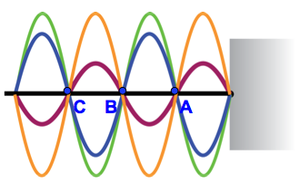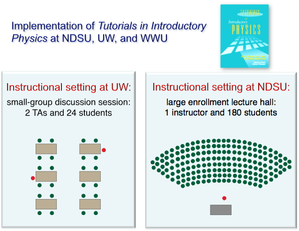Description of current research projects
Focus: Metacognition
Project 1. Confirmation Bias in Science: Investigation of student reasoning in physics courses
The term "confirmation bias" refers to a tendency to favor evidence that confirms specific preconceived notions, believes, expectations, or even hypothesis at hand. "When men wish to construct or support a theory, how they torture facts into their service!" (Mackay). Understanding the difference between (1) impartially interpreting data in order to arrive at an unbiased conclusion and (2) selectively interpreting data to justify a specific conclusion is particularly important for science and engineering students. However, many introductory physics student responses to a variety of tasks suggest that students tend to apply both thinking schemas when presented with an unfamiliar situation. While one schema involves an unbiased and systematic analysis of a presented situation, the other reveals reasoning steps that lead to an intuitive answer that is perhaps more intuitively appealing to a student. This project focuses on probing whether the latter reasoning pattern is consistent with the confirmation bias.
Project personnel and collaborators: Mila Kryjevskaia, Nate Grosz (NDSU), MacKenzie Stetzer (University of Maine)
Project 2. Answer first: Applying heuristic-analytic theory of reasoning to examine student intuitive thinking in the context of physics
This study is motivated by the emerging body of evidence that suggests that student conceptual and reasoning competence demonstrated on one task often fails to be exhibited on another. Indeed, even after instruction specifically designed to address student conceptual and reasoning difficulties identified by rigorous research, many undergraduate physics students fail to build reasoning chains from fundamental principles even though they possess required knowledge and skills to do so. Instead, they often rely on a variety of intuitive reasoning strategies. In this study, we have developed methodology that allowed for the disentanglement of student conceptual understanding and reasoning approaches. We then apply heuristic-analytic theory of reasoning in order to account for, in a mechanistic fashion, the observed inconsistencies in student responses. We argue that efforts to improve student metacognition, which serves to regulate the conflict between intuitive and analytical reasoning, are likely to lead to improved student reasoning.
Project personnel and collaborators: Mila Kryjevskaia, MacKenzie Stetzer (U. of Maine), Nate Grosz, Levi Remily, Austin Usselman

Projects focusing on metacognition are supported, in part, by the National Science Foundation, DUE-1245999.

Student difficulties measuring distance in terms of wavelength: lack of basic skills or failure to transfer?
In a prior investigation that focused on the transmission of periodic waves at the boundary between two media, we documented difficulties with the basic concepts of wavelength, frequency, and propagation speed, and with the relationship v = f λ. (See our paper published in AJP.) In the current investigation, we probe student abilities to apply this relationship in problems involving two-source and thin-film interference. In both cases, interference arises from differences in the pathlengths traveled by two waves. We found that some students (up to 40% on certain questions) had difficulty with a task that is fundamental to understanding of these phenomena: expressing a physical distance, such as the separation between two sources, in terms of the wavelength of a periodic wave. We administered a series of questions to try to identify factors that influence student performance. It appears that that most incorrect responses stem from erroneous judgment about the type of reasoning required, not an inability to do said reasoning. A number of students do not seem to treat the spacing of moving wavefronts as analogous to the "immutable" measurement tools (e.g., rulers).
Project personnel and collaborators: Mila Kryjevskaia, MacKenzie Stetzer (U. of Maine), Paula Heron (U. of Washington), and Alexandra Lau (Mount Holyoke College)
<link typo3 sysext rtehtmlarea mod4> This project is supported, in part, by the National Science Foundation, DUE-124599, REU program Growing up STEM
This project is supported, in part, by the National Science Foundation, DUE-124599, REU program Growing up STEM
Assessing the flexibility of research-based instructional strategies: Implementing Tutorials in Introductory Physics in the lecture environment
This project seeks to lower perceived barriers by documenting the learning gains that can be achieved when a Physics Education Research-based curriculum is implemented in a new setting. We implement materials from Tutorials in Introductory Physics (originally designed and implemented by the Physics Education Group at the University of Washington) in modified form as interactive lectures under conditions significantly different from those suggested by the curriculum developers. Student learning is assessed using tasks drawn from the physics education research literature. Our current findings suggest that the use of tutorials in the interactive lecture format yields gains in student understanding comparable to those obtained through the canonical tutorial implementation at the University of Washington. These findings suggest that student engagement with the intellectual steps laid out in the tutorials, rather than the specific strategies used in facilitating such engagement, plays the central role in promoting student learning.
Project personnel and collaborators: Mila Kryjevskaia, Andrew Boudreaux, and Dustin Heins (WWU)

Spatial reasoning: a potential roadblock to conceptual understanding of Physics?
Research suggests that even after targeted instruction on many physics topics some students still are not able to systematically analyze complex unfamiliar situations. As researchers, curriculum developers, and physics instructors, we feel that one of the weaknesses in our current understanding of student learning is an inability to differentiate clearly between those student difficulties that stem from inadequate understanding of subject matter and those that are due to other factors. This distinction is critical to efforts to improve student learning of physics. We hypothesize that poor performance on some physics tasks may be attributable to student difficulties in visualizing and reasoning spatially. Therefore, we will probe the extent to which student understanding of some phenomena hinges on visualization skills by examining the degree of association between student performance on many tasks and on a spatial visualization test (paper folding test). We attempt to distinguish between student difficulties that are due to deficiencies with conceptual understanding and those that are due to lack of visualization skills.
Project Personnel: Mila Kryjevskaia, Alexandra Lau (Mount Holyoke College)
 This project is supported, in part, by the National Science Foundation, DUE-124599, REU program Growing up STEM
This project is supported, in part, by the National Science Foundation, DUE-124599, REU program Growing up STEM
Description of past research projects
Interpreting multi-variable expressions in Physics: Patterns in student reasoning
Many physics instructors would agree that mathematics is an essential element of physics problem solving. However, the way mathematics is used is physics courses is distinctly different from the way it is taught. In physics, conceptual understanding of a specific phenomenon is imbedded in a symbolic form. As a result, without a robust understanding of physics concepts, simple manipulation of symbols in mathematical expressions is often inappropriate and unhelpful. In the context of a math course, for example, it may be appropriate to reason that, for the given relationship y = x/a, if x increases, y must also increase; in such cases, it is commonly assumed that variables (e.g., x and y) and constants (e.g., positive a) have been clearly established. However, a direct mapping of the same reasoning in the context of physics (namely, for the given relationship f= v/λ, if the propagation speed v increases, frequency f must also increase) leads to an erroneous conclusion. In order to correctly interpret the relationship among the wavelength, frequency, and propagation speed, students must possess a conceptual understanding of the propagation speed and recognize that v could be change only by changing medium (in non-dispersive media). Therefore, a modification to a source (or f) affects the wavelength rather than the speed. Similarly, many students think that the capacitance will always change if the potential difference between the capacitor's plates is changed. In this investigation we probe the extent to which students' incorrect reasoning approaches could be altered by making explicit connections during instruction between the treatments of multi-variable expressions in several contexts, such as waves and electrostatics. We also examine students' ability to transfer their understanding between these contexts.
Project personnel and collaborators: Mila Kryjevskaia, Cody Gette
Interdisciplinary research: Using assessments to investigate and compare the nature of learning in undergraduate science courses
Assessments such as exams and quizzes are routine in undergraduate science courses. Understanding the numerous possible factors impacting students' performance on these assessments is a complex problem. Prior research suggests that the difficulty of any exam/quiz question is dependent not only on the cognitive skills required to answer the question but also other factors such as surface features of the problem, context (both of the content assessed as well as the course in which the student is enrolled), and linguistic complexity. The goal of this study is to understand the relationship between student performance on assessments in introductory science courses and mediating factors such as cognitive level, linguistic complexity, and degree of abstractness of the content assessed.
Project personnel and Collaborators: Erika G. Offerdahl and James Nyachwaya (Dept. of Chemistry and Biochemistry, NDSU) Jennifer Momsen (Dept. of Biological Sciences, NDSU), Mila Kryjevskaia and Nate Grosz (Dept. of Physics, NDSU)
This Web page represents the views of the author and not necessarily those of North Dakota State University.
NDSU is not responsible or liable for its contents.

